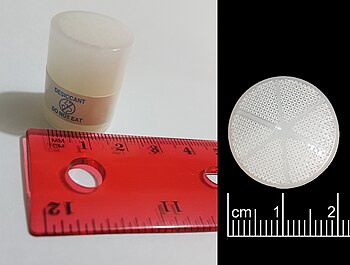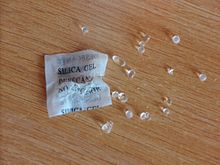295:
43:
175:
27:
83:. Desiccants for specialized purposes may be in forms other than solid, and may work through other principles, such as chemical bonding of water molecules. They are commonly encountered in foods to retain crispness. Industrially, desiccants are widely used to control the level of water in gas streams.
271:
against moisture damage: rust, corrosion, etc. Hygroscopic cargo, such as cocoa, coffee, various nuts and grains, and other foods can be particularly susceptible to mold and rot when exposed to condensation and humidity. Because of this, shippers often take measures by deploying desiccants to
263:
where zeolite spheroids fill a rectangular spacer tube at the perimeter of the panes of glass. The desiccant helps to prevent the condensation of moisture between the panes. Another use of zeolites is in the "dryer" component of refrigeration systems to absorb water carried by the refrigerant,
327:. The method generally, though not always, involves mixing the solvent with the solid desiccant. Studies show that molecular sieves are superior as desiccants relative to chemical drying reagents such as sodium-benzophenone. Sieves offer the advantages of being safe in air and recyclable.
166:. To some extent, desiccant performance can be precisely described, but most commonly, the final choice of which desiccant best suits a given situation, how much of it to use, and in what form, is made based on testing and practical experience.
415:
279:
Desiccants induce dryness in any environment and reduce the amount of moisture present in air. Desiccants come in various forms and have found widespread use in the food, pharmaceuticals, packing, electronics and many manufacturing industries.
105:, an otherwise inert, nontoxic, water-insoluble white solid. Tens of thousands of tons are produced annually for this purpose. Other common desiccants include
132:
Alcohols and acetones are also dehydrating agents. Development of desiccants made of treated rice husks is a promising use of waste agricultural products.
309:
to produce dry, oxygen-free toluene. The toluene is dry and oxygen free when the intense blue coloration from the benzophenone ketyl radical is observed.
611:
Williams, D. Bradley G.; Lawton, Michelle (2010). "Drying of
Organic Solvents: Quantitative Evaluation of the Efficiency of Several Desiccants".
286:
Desiccants are used in livestock farming, where, for example, new-born piglets are highly susceptible to hypothermia owing to their wetness.
125:). Desiccants may also be categorized by their type, either I, II, III, IV, or V. These types are a function of the shape of the desiccant's
264:
whether residual water left over from the construction of the system, or water released by the degradation of other materials over time.
186:
is included in the desiccant to show, by color changes, the degree of water-saturation of the desiccant. One commonly used indicator is
283:
Air conditioning systems can be based on desiccants, as drier air feels more comfortable and absorbing water itself removes heat.
537:
Vande Pol, Katherine D.; Tolosa, Andres F.; Shull, Caleb M.; Brown, Catherine B.; Alencar, Stephan A S.; Ellis, Michael (2020).
464:"Simulation of Moisture and Chlorophyll Changes in Dried Laver, Porphyra Yezoensis, in a Desiccant-Enclosing Packaging System"
595:
276:
often includes small packets of desiccant to keep the atmosphere inside the package below critical levels of water vapor.
658:
Lavan, Z.; Jean-Baptiste
Monnier & Worek, W. M. (1982). "Second Law Analysis of Desiccant Cooling Systems".
396:
Otto W. Flörke, et al. "Silica" in
Ullmann's Encyclopedia of Industrial Chemistry, 2008, Weinheim: Wiley-VCH, .
441:
MIL-D-3464E, MILITARY SPECIFICATION: DESICCANTS, ACTIVATED, BAGGED, PACKAGING USE AND STATIC DEHUMIDIFICATION
372:
101:, others are extremely reactive and require specialized handling techniques. The most common desiccant is
417:
A Protective packaging evaluation involving a high barrier film lamiation, desiccants and oxygen absorbers
351:
244:
126:
539:"Effect of method of drying piglets at birth on rectal temperature over the first 24 h after birth1"
463:
273:
439:
346:
356:
77:
8:
719:
187:
724:
698:
636:
563:
538:
485:
341:
314:
268:
183:
106:
92:
54:
628:
591:
568:
489:
324:
260:
163:
152:
702:
640:
690:
667:
620:
558:
550:
519:
475:
397:
361:
294:
114:
98:
35:
20:
401:
681:
323:, typically required by chemical reactions that do not tolerate water, e.g., the
118:
42:
523:
480:
713:
267:
Bagged desiccants are also commonly used to protect goods in barrier-sealed
231:). Further hydration results in the pink hexaaquacobalt(II) chloride complex
632:
572:
510:
Daou, K; Wang, Xia (2005). "Desiccant cooling air conditioning: a review".
377:
306:
657:
554:
159:
69:
65:
585:
174:
694:
336:
248:
141:
102:
46:
31:
671:
624:
203:
73:
679:
S. Sadik; J. W. White (1982). "True potato seed drying over rice".
320:
110:
26:
367:
298:
122:
76:. Commonly encountered pre-packaged desiccants are solids that
68:
substance that is used to induce or sustain a state of dryness (
302:
50:
19:
For the use of chemicals in agriculture to aid harvesting, see
80:
145:
206:, but turns purple upon bonding with two water molecules (
38:
used as desiccant in drug containers to keep contents dry.
536:
259:
One example of desiccant usage is in the manufacture of
144:) of water storable in the desiccant relative to the
140:
One measure of desiccant efficiency is the ratio (or
678:
586:Chai, Christina Li Lin; Armarego, W. L. F. (2003).
711:
169:
610:
319:Desiccants are also used to remove water from
509:
243:. However, the use of cobalt chloride raises
158:The performance of any desiccant varies with
72:) in its vicinity; it is the opposite of a
16:Substance used to induce or sustain dryness
562:
479:
135:
512:Renewable and Sustainable Energy Reviews
420:(MSc). Rochester Institute of Technology
293:
173:
41:
25:
155:of the air or other fluid being dried.
712:
461:
86:
413:
289:
588:Purification of laboratory chemicals
660:Journal of Solar Energy Engineering
30:Canisters are commonly filled with
13:
651:
14:
736:
590:. Oxford: Butterworth-Heinemann.
613:The Journal of Organic Chemistry
151:Another measure is the residual
468:Nippon Shokuhin Kogyo Gakkaishi
254:
162:and both relative humidity and
604:
579:
530:
503:
455:
432:
407:
390:
1:
402:10.1002/14356007.a23_583.pub3
383:
170:Colored saturation indicators
97:Although some desiccants are
543:Translational Animal Science
373:Volatile corrosion inhibitor
301:is heated under reflux with
7:
330:
10:
741:
524:10.1016/j.rser.2004.09.010
481:10.3136/nskkk1962.32.4_266
352:Moisture sorption isotherm
312:
127:moisture sorption isotherm
90:
18:
274:Pharmaceutical packaging
347:Humidity indicator card
272:protect against loss.
357:Solar air conditioning
310:
202:), which is blue when
179:
136:Performance efficiency
57:
39:
297:
178:Indicating silica gel
177:
45:
29:
247:, being potentially
555:10.1093/tas/txaa183
269:shipping containers
87:Types of desiccants
695:10.1007/BF02357312
462:Hirata, T (1985).
342:Humidity buffering
315:Air-free technique
311:
290:Drying of solvents
184:humidity indicator
180:
107:activated charcoal
93:List of desiccants
58:
40:
672:10.1115/1.3266307
625:10.1021/jo101589h
619:(24): 8351–8354.
597:978-0-7506-7571-0
414:Rollo, P (1996).
364:(oxygen absorber)
325:Grignard reaction
261:insulated windows
164:absolute humidity
153:relative humidity
732:
706:
675:
645:
644:
608:
602:
601:
583:
577:
576:
566:
534:
528:
527:
507:
501:
500:
498:
496:
483:
459:
453:
452:
451:
449:
436:
430:
429:
427:
425:
411:
405:
394:
362:Oxygen scavenger
242:
241:
240:
230:
228:
227:
217:
216:
215:
201:
200:
199:
119:molecular sieves
115:calcium chloride
99:chemically inert
36:molecular sieves
21:crop desiccation
740:
739:
735:
734:
733:
731:
730:
729:
710:
709:
682:Potato Research
654:
652:Further reading
649:
648:
609:
605:
598:
584:
580:
535:
531:
508:
504:
494:
492:
460:
456:
447:
445:
438:
437:
433:
423:
421:
412:
408:
395:
391:
386:
333:
317:
292:
257:
245:health concerns
239:
236:
235:
234:
232:
226:
223:
222:
221:
219:
214:
211:
210:
209:
207:
198:
195:
194:
193:
191:
188:cobalt chloride
172:
138:
111:calcium sulfate
95:
89:
24:
17:
12:
11:
5:
738:
728:
727:
722:
708:
707:
676:
666:(3): 229–236.
653:
650:
647:
646:
603:
596:
578:
549:(4): txaa183.
529:
502:
474:(4): 266–273.
454:
431:
406:
388:
387:
385:
382:
381:
380:
375:
370:
365:
359:
354:
349:
344:
339:
332:
329:
313:Main article:
291:
288:
256:
253:
237:
224:
212:
196:
171:
168:
148:of desiccant.
137:
134:
91:Main article:
88:
85:
15:
9:
6:
4:
3:
2:
737:
726:
723:
721:
718:
717:
715:
704:
700:
696:
692:
688:
684:
683:
677:
673:
669:
665:
661:
656:
655:
642:
638:
634:
630:
626:
622:
618:
614:
607:
599:
593:
589:
582:
574:
570:
565:
560:
556:
552:
548:
544:
540:
533:
525:
521:
517:
513:
506:
491:
487:
482:
477:
473:
469:
465:
458:
443:
442:
435:
419:
418:
410:
403:
399:
393:
389:
379:
376:
374:
371:
369:
366:
363:
360:
358:
355:
353:
350:
348:
345:
343:
340:
338:
335:
334:
328:
326:
322:
316:
308:
304:
300:
296:
287:
284:
281:
277:
275:
270:
265:
262:
252:
250:
246:
205:
189:
185:
176:
167:
165:
161:
156:
154:
149:
147:
143:
133:
130:
128:
124:
120:
116:
112:
108:
104:
100:
94:
84:
82:
79:
75:
71:
67:
63:
56:
52:
48:
44:
37:
33:
28:
22:
686:
680:
663:
659:
616:
612:
606:
587:
581:
546:
542:
532:
518:(2): 55–77.
515:
511:
505:
493:. Retrieved
471:
467:
457:
446:, retrieved
440:
434:
422:. Retrieved
416:
409:
392:
378:Cromer cycle
318:
307:benzophenone
285:
282:
278:
266:
258:
255:Applications
249:carcinogenic
182:Sometimes a
181:
157:
150:
139:
131:
121:(typically,
96:
61:
59:
160:temperature
70:desiccation
66:hygroscopic
720:Desiccants
714:Categories
689:(3): 269.
384:References
337:Desiccator
142:percentage
103:silica gel
53:or porous
47:Silica gel
34:and other
32:silica gel
725:Packaging
495:11 August
490:101082998
448:August 8,
424:August 8,
204:anhydrous
74:humectant
62:desiccant
703:41039047
641:17801540
633:20945830
573:33241187
331:See also
321:solvents
123:zeolites
564:7672461
368:Sorbent
299:Toluene
701:
639:
631:
594:
571:
561:
488:
444:, 1987
303:sodium
117:, and
78:absorb
55:packet
51:sachet
699:S2CID
637:S2CID
486:S2CID
81:water
64:is a
49:in a
629:PMID
592:ISBN
569:PMID
497:2021
450:2021
426:2021
305:and
208:CoCl
192:CoCl
146:mass
691:doi
668:doi
664:104
621:doi
559:PMC
551:doi
520:doi
476:doi
398:doi
716::
697:.
687:25
685:.
662:.
635:.
627:.
617:75
615:.
567:.
557:.
545:.
541:.
516:10
514:.
484:.
472:32
470:.
466:.
251:.
233:Cl
218:·2
129:.
113:,
109:,
60:A
705:.
693::
674:.
670::
643:.
623::
600:.
575:.
553::
547:4
526:.
522::
499:.
478::
428:.
404:.
400::
238:2
229:O
225:2
220:H
213:2
197:2
190:(
23:.
Text is available under the Creative Commons Attribution-ShareAlike License. Additional terms may apply.


